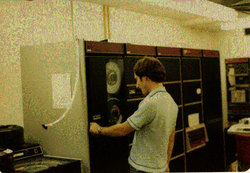


|

|
|
Harley Hahn's
File Sharing
Le petit guide
Master List
•
Top Usenet
•
Top Usenet
|
HARLEY HAHN'S USENET CENTER
USENET is a vast, global system of discussion and file sharing groups. There are over a hundred thousand different groups and millions of participants all over the world. Usenet was started in 1979 by two graduate students at Duke University, Jim Ellis and Tom Truscott. Usenet was conceived as a way to send news and announcements between two universities in North Carolina (University of North Carolina and Duke University). Within a short time, however, the system had spread to other schools, and it soon developed into a system of discussion groups. 
Jim Ellis (1956-2001), Usenet co-creator;
Because of its origin, Usenet is still referred to as the NEWS, or sometimes NETNEWS, even though it is not a news service. Similarly, the discussion groups are often referred to as NEWSGROUPS or, more simply, GROUPS. Like other Internet services, Usenet uses a CLIENT/SERVER SYSTEM, in which you use a program called a CLIENT (that runs on your computer) to request services from a program called a SERVER (that runs on a remote computer). For example, when you use the Web, your browser acts as a Web client to communicate on your behalf with remote Web servers. To access Usenet, you use a client program called a NEWSREADER to connect to a remote NEWS SERVER. Usenet works as follows. People send messages, called ARTICLES or POSTINGS, to the various newsgroups. When you send an article, we say that you POST it. Most articles consist of text, but some also have an ATTACHMENT: a file embedded within the article, that is transported along with the article itself. An attachment can hold any type of data, which means that Usenet can be used to share any type of file. Most commonly, attachments are used to share photos, music, videos and software. (We'll discuss the details later.) Usenet is designed so that articles are propagated automatically around the world, moving from one news server to another. (I'll explain how this works in the next section of the tutorial.) When you want to look at the articles within a particular newsgroup, you use your newsreader to connect to a news server. You tell the newsreader which newsgroup you want to read, and it displays a summary of all the articles from that group. You select the ones you want to read, and your newsreader displays them for you. Interesting note: Over the years, more and more universities have stopped offering Usenet service. (As we will discuss later, the gap has been filled by commercial Usenet providers.) On May 20, 2010, Duke University permanently turned off its Usenet server, officially shutting down, forever, the world's first Usenet system.
© All contents Copyright 2025, Harley Hahn
|